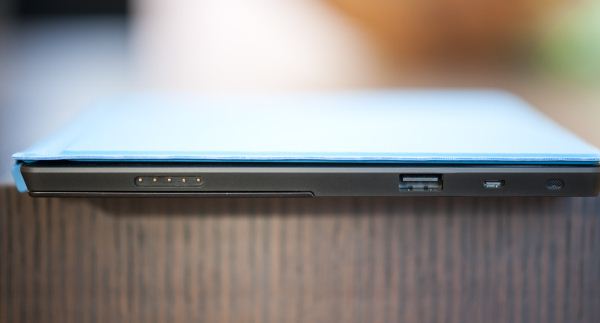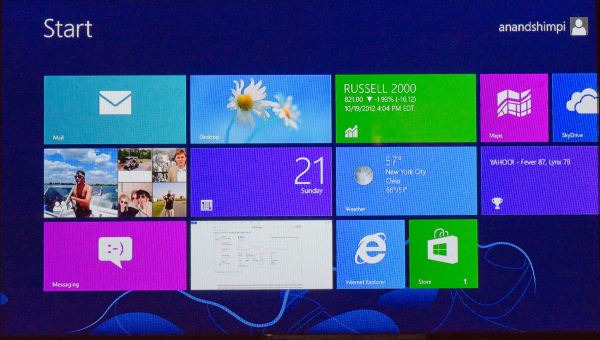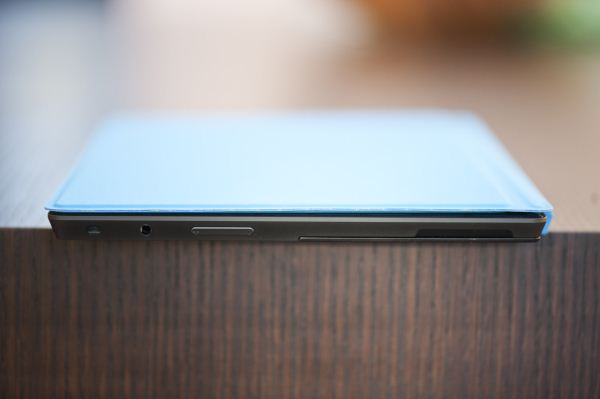Microsoft Surface Review
by Anand Lal Shimpi on October 23, 2012 9:01 PM EST- Posted in
- Tablets
- Microsoft
- Mobile
- Surface
- Windows RT
A Plethora of Ports and Storage Options
One area where Surface is a significant departure from the iPad is in its IO and expansion. The iPad features a single dock (and soon to be Lightning) connector, while Surface looks more like a laptop (or Android tablet) when it comes to IO.
There’s no port for syncing, you get content onto Surface via WiFi or a more traditional method. Surface has a single USB 2.0 port on the right side of the device. You can plug almost anything you want into this port, including USB storage devices of course. Behind the kickstand is a single microSD card slot, giving you another option for expansion.
On the left edge of the device there’s a micro-HDMI out port that can be paired with a Microsoft made VGA or HDMI dongle (both dongles have a 22-degree connector on them to mate flush with Surface). I tested HDMI output with Microsoft's dongle and unfortunately the result wasn't very good. The 1080p output had a lot of issues with scaling quality (as you can see from the shot below) and there was a lot of tearing on the screen with a big impact on UI frame rate. I reached out to Microsoft for an explanation but have yet to hear anything.
Finally there’s a standard 1/8” headphone jack along the top of the device.
Power delivery comes via a custom magnetic connector along the lower right side of Surface.
Given that the internal storage is an eMMC solution, performance from the microSD slot with a good card should be fairly comparable. In practice I could read and write a large sequential file at roughly 10.5 MB/s using a SanDisk microSD card.
Copying from a fast USB stick to Surface’s internal storage gave me transfer rates closer to 17MB/s. There are a few vendors for Windows 8/RT eMMC devices, I’ll be paying close attention over the coming weeks to figure out who makes the best. I know Microsoft and Intel (among others) have been playing close attention to the eMMC providers with hopes of weeding out those that deliver honestly unacceptable performance.
While doing background file IO I didn’t notice any of the stalling/pausing that we’ve seen on some of the more recent Android tablets.
Update: Many have asked about how much storage is taken up by the Windows + Office 2013 installs. The screenshot below shows the directory size for both C:\Windows and C:\Program Files, the latter is where the Office15 install files are included (and yes winword.exe is still the Word executable).
You're looking at roughly 6.47GB for Windows RT and then another 830MB for Office for a grand total of around 7.3GB.
USB Compatibility
Microsoft is particularly proud of its single USB 2.0 port on Surface. Although USB ports have been featured on several Android tablets, their support was typically limited to flash drives, keyboards and mice. With Windows RT, Microsoft wants to bring more of the traditional Windows experience to tablets. Had Surface been x86 based, you would be able to plug in virtually any USB peripheral and it would just work. As the first version of Surface is based on an ARM SoC, driver support is a little more limited but still pretty decent.
USB drives obviously work as you’d expect them to. Even SATA to USB adapters worked fine when plugged into Surface. Other smartphones and tablets also worked, although their level of support varied. For example, you can plug in the iPhone 5 and have it come up as a supported device for moving pictures to/from. However USB tethering is not supported by the class driver included in Windows RT. You can even plug an iPad into Surface and get the same level of support.
Printer support is pretty decent, although the Epson Workforce 910 I tried didn’t actually have specific driver support under RT. Although development for the desktop side of Windows is limited, manufacturers can supply Windows RT drivers to enable support for some more obscure devices. Unfortunately when it comes to those devices you’ll have to play the waiting game as there’s simply not a lot of third party Windows RT drivers available for download today.






_575px.png)








235 Comments
View All Comments
walkman - Friday, October 26, 2012 - link
Did anyone else go back and check the byline for this article? I highly respect Anandtech reviews but this one was written with a glibness and giddiness that seems very uncharacteristic. If it wasn't Anand I would write it off as a MS PR hack, but it is so I'm trying to keep an open mind. Anand review are usually very late so it's also surprising to see this detailed review so quickly. He likes RT so much he makes sound like he will like better than Win 8. Perhaps he has a bias for MS (I do) so he's just excited to see MS get back in the game vs competitors.twotwotwo - Saturday, October 27, 2012 - link
The Atom/ARM head-to-head is awesome. Noteworthy that the Exynos 5 Dual in the Chromebook got a 711ms SunSpider score (in another site's test) compared to the 714ms for Atom here, and x86 usually smashed on SunSpider in the past because of its wider memory interface. (Of course, I'm implicitly comparing Google's JavaScript VM against Microsoft's too, not just the chips. And someone actually buying a Windows tablet might go Atom just to get Windows 8 and legacy app compatibility instead of RT.)Bet I'll hear more about the ARM-meets-Atom thing in your Chromebook review. For me as a user, seems like the big deal is that mobile architecture wars are on like Donkey Kong; only good news for me.
MrSpadge - Saturday, October 27, 2012 - link
Wow.. imagine we could get this pixel density, IPS and almost 1:1400 static contrast on any regular laptop display! It may not beat the iPad3 display.. but in absolute terms and especially compared to what we usually get any 500€ or 2000€ machine this is just gorgeous!I also can't understand people wanting an even higher resolution stating "but Apple's got the higher dpis". Personally I find 1366 x 768 to be very crisp and borderline too small at 11.6", so there'd be no benefit of going smaller but drawbacks (scaling, power consumption, cost). I don't think the trade-off would have been worth it.
johnsmith9875 - Tuesday, October 30, 2012 - link
But does Surface run in Portrait mode? Does the hardware have the position sensors and does the software check for those? I've seen it only being demonstrated in landscape mode.crispbp04 - Monday, November 5, 2012 - link
Yes, it is beautiful in portrait and landscapebhima - Tuesday, October 30, 2012 - link
Haswell + Win8 x86 will be epic. I don't care about RT. In fact, it feels like Microsoft is hedging its bets with RT vs its x86 Surface tablets. Here's hoping x86 stays around so you can actually use software you already own, have real application choices and have a truly seemless integration between tablet, notebook and desktop... not just some fancy looking sync software.Silma - Monday, November 5, 2012 - link
Congratulations on the most informative review of the Surface I read to date.Surface seems exciting although a sub FullHD screen and only 2GB of RAM are a big turnoff.
I am looking forward to reading your review of the Surface Pro when it becomes available.
ezrasam - Thursday, November 8, 2012 - link
Revolution of the decade.ijabit - Tuesday, November 20, 2012 - link
I can confirm that I had the exact same problem outputting video to my 42" plasma. The poor quality was very noticable and one of the main reasons I returned it (we watch a lot of netflix streaming from a PC). I never had a problem with my (super slow) Asus laptop and HDMI out.bogieworf - Wednesday, November 28, 2012 - link
I personally used the new Nook HD + before returning it and replacing it with the Surface. My wife owns the iPAD 3. Here are my thoughts about the devices.If the Nook HD+ (9" model) isn't the perfect e-Reader, it is close to it. Anything larger would require two hands. The case that BN offers for the Nook allows standing the Nook either upright or sideways, and the software is great for reading. Unfortunately, BN's tech support leaves much to be desired and I was forced to return the device because they could not find out why one of my daily newspapers was not being automatically downloaded each day. Sad, really, because I REALLY like the device. But make no mistake, this is an e-Reader first and secondarily everything else.
Going from the Nook to the Surface, the Surface is much more expensive and much more versatile. Windows R/T is a pretty slick piece of SW. Love the Tiles being able to re-arrange them and the updates that appear in the Tiles. Is the Surface as good a reader? No, its too big as you need two hands to hold the device. Is it an more than adequate reader? Yes.
The Surface is a tablet designed primarily for media consumption and secondarily for productivity. It is currently THE tablet to own if you value productivity. Word, Excel and Power Point come pre-loaded. The keyboard that doubles as a cover is a great design as is the built in kick stand. This device has the advantages of the much touted Yoga in a much smaller, thinner and lighter package. The iPAD simply does not compare as a productivity device and the Tiles with auto updating makes iOS seem dated. Is the iPAD the better media consumption device? Yes. The display and apps place the iPAD well in front of the Surface, but the more you value productivity, the more the Surface makes sense.
But understand, the Surface offers a light version of productivity for most people. If productivity is your first concern, something the size of a convertible (12.5" or more) would be much better. The Yoga, for example, would be a good productivity device while still being thin and light enough to secondarily offer decent media consumption and portability. But the Yoga is not a device you are likely to pull out during your daily commute, at least not on the subway. It is too big and cumbersome for that, the Surface is not.
Taken for what it is and what it offers, the Surface is a great device for the right person. You need to appreciate the Surface for what it is and what it was designed to do, not for failing to be something it was never intended to be. If nothing else, MS should be credited for re-thinking the tablet space and not producing another iPAD wannabe. This is a very well thought out and executed product..